Playing steel drums in sound healing settings offers a unique and resonant experience, blending the vibrant tones of these instruments with the therapeutic intentions of sound healing. Here’s a concise guide to help you explore the art of playing steel drums in a way that enhances the healing qualities of the sound.

1. Instrument Selection: Choose steel drums with mellow and soothing tones, as certain scales and pan types are more conducive to the calming atmosphere of sound healing sessions. Options like the Integral or Celtic minor scales are popular for their harmonious and therapeutic qualities.
2. Mindful Playing Techniques: Engage in mindful playing techniques that prioritize gentle and deliberate strikes on the drum surface. The goal is to produce soft, sustained notes that resonate with the healing intentions of the session. Experiment with rolling, tapping, and mallet techniques to evoke a range of soothing sounds.
3. Exploration of Harmonies: Delve into the harmonies and melodic possibilities of the steel drum. Create sequences that evoke a sense of tranquility and balance. Consider the emotional nuances of different scales and explore how they can contribute to the overall healing atmosphere.
4. Collaboration with Other Instruments: Incorporate the steel drum harmonies into a broader ensemble of healing instruments. Collaborate with singing bowls, chimes, or other complementary instruments to create a layered and immersive sonic experience. The synergy of diverse instruments can amplify the therapeutic impact.
5. Rhythmic Foundations: While emphasizing melodic exploration, remember the rhythmic potential of steel drums. Use the lower-pitched drums to establish a grounding rhythmic foundation that resonates with the Earth element, contributing to a sense of stability and rootedness in the healing space.
6. Intuitive and Responsive Playing: Cultivate an intuitive and responsive approach to playing steel drums in sound healing settings. Pay attention to the energy of the space, the participants, and the overall intention of the session. Allow the music to flow organically, adapting to the evolving needs of the healing environment.
7. Mindful Breath and Presence: Incorporate mindful breathing and presence into your playing. Align your breath with the rhythm and allow the act of playing to become a meditative practice. This not only enhances your connection with the instrument but also contributes to the overall sense of mindfulness in the space.
8. Post-Session Reflection: After the sound healing session, take a moment for personal reflection. Consider the impact of your playing on the participants and the overall energy of the space. This reflective practice allows you to refine your approach and deepen your understanding of the symbiotic relationship between the steel drum and sound healing.
Playing steel drums in a sound healing context is a dynamic and creative endeavor. With a mindful and intentional approach, these instruments can become powerful tools for facilitating relaxation, emotional release, and a harmonious connection between mind, body, and spirit.